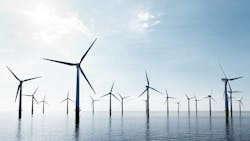U.S. DOE And DOI Release Action Plan for Offshore Wind Transmission Development in The Atlantic Region
The Department of Energy and the Department of the Interior recently released a plan outlining the actions they say are needed to connect the first generation of Atlantic offshore wind projects to the electric grid, as well as to increase transmission resources over the next several decades.
An Action Plan for Offshore Wind Transmission Development in the U.S. Atlantic Region, which was developed by DOE’s Grid Deployment and Wind Energy Technologies Offices and DOI’s Bureau of Ocean Energy Management, aims to coordinate planning in order to speed up timelines and lower project costs, while strengthening grid reliability and resilience.
Over the mid- to long-term, increased intra-regional coordination, shared transmission lines, and an offshore network of high voltage direct current interlinks can more efficiently bring offshore energy onshore, the DOE said.
At the same time, the DOE also announced the launch of the Tribal Nation Technical Assistance Program for Offshore Wind Transmission, which offers education and training resources to support engagement in offshore wind planning and was created in direct response to tribal input.
The recommendation include:
- Before 2025 - Establish collaborative bodies that span the Atlantic Coast region; clarify some of the building blocks of transmission planning, including updating reliability standards and identifying where offshore transmission may interconnect with the onshore grid; and address costs through voluntary cost assignments and tax credits;
- From 2025 to 2030 - Simultaneously convene and coordinate with states to plan for an offshore transmission network; with industry to standardize requirements for HVDC technology; and with federal agencies, tribal nations, state agencies, and stakeholders to identify and prioritize transmission paths on the outer continental shelf;
- From 2030 -- establish a national HVDC testing and certification center to ensure compatibility when interconnecting multiple HVDC substations to form an offshore grid network.
Together, the action plan and the tribal assistance program will advance equitable and sustainable offshore wind energy development, domestic manufacturing, and grid integration, as part of broader efforts across the Biden-Harris administration to deploy 30 gigawatts of offshore wind in the United States by 2030, unlocking a pathway to 110 GW or more by 2050, the DOE said.
About the Author
T&D World Staff
Content Team
Nikki Chandler
Group Editorial Director, Energy
[email protected]
Jeff Postelwait
Managing Editor
[email protected]
Christina Marsh
Senior Editor
[email protected]
Ryan Baker
Associate Editor
[email protected]
Amy Fischbach
Electric Utility Operations
[email protected]
Rich Maxwell
Community Editor
[email protected]
Gene Wolf
Technical Editor
[email protected]
